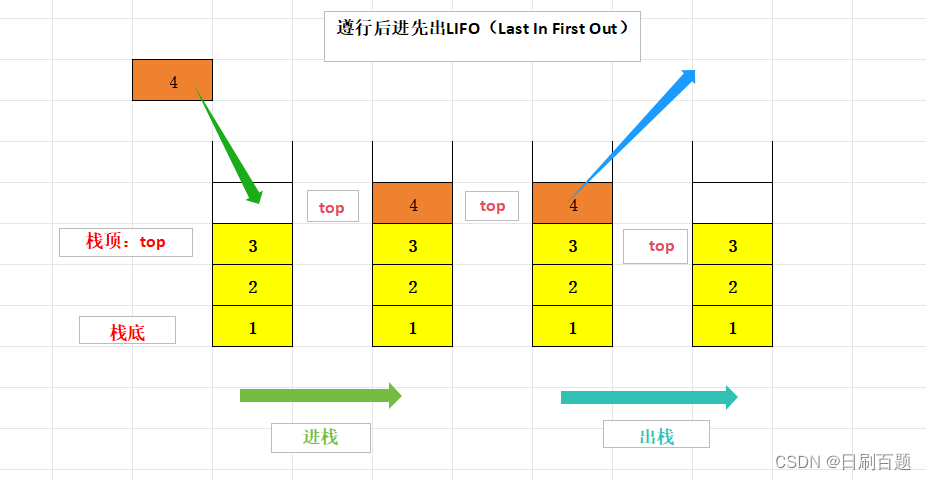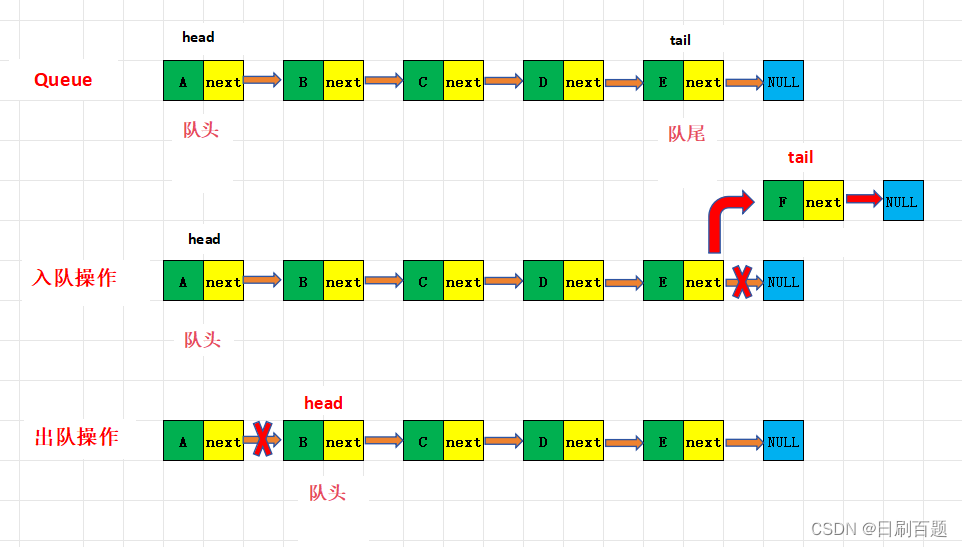-
数据结构——栈与队列
一、栈
1.1 栈的概念及结构
栈:一种特殊的线性表,其只允许在固定的一端进行插入和删除元素操作。 进行数据插入和删除操作的一端 称为栈顶,另一端称为栈底。 栈中的数据元素遵守后进先出 LIFO ( Last In First Out )的原则。压栈 :栈的插入操作叫做进栈 / 压栈 / 入栈, 入数据在栈顶。出栈 :栈的删除操作叫做出栈。 出数据也在栈顶。

1.2.1 栈的基本功能实现
- #include
- #include
- #include
- typedef int SDateType;
- typedef struct Stack
- {
- SDateType* a;
- int top;
- int capacity;
- }Stack;
- //初始化栈和销毁栈
- void InitStack(Stack* ps);
- void DestoryStack(Stack* ps);
- //出栈和入栈
- void StackPush(Stack* ps, SDateType x);
- void StackPop(Stack* ps);
- //栈的有效个数和栈顶元素
- int StackSize(Stack* ps);
- int StackTop(Stack* ps);
- //栈是否为空
- bool StackEmpty(Stack* ps);
1.2.1.1 栈的初始化和销毁
- //初始化栈和销毁栈
- void InitStack(Stack* ps)
- {
- assert(ps);
- ps->a = NULL;
- ps->capacity = ps->top = 0;
- }
- void DestoryStack(Stack* ps)
- {
- assert(ps);
- free(ps->a);
- ps->a = NULL;
- ps->capacity = ps->top = 0;
- }
1.2.1.2 入栈和出栈
- //出栈和入栈
- void StackPush(Stack* ps, SDateType x)
- {
- assert(ps);
- //扩容
- if (ps->top == ps->capacity)
- {
- SDateType newcapacity = ps->capacity == 0 ? 4 : ps->capacity * 2;
- SDateType* tmp = (SDateType*)realloc(ps->a,newcapacity*sizeof(SDateType));
- if (tmp == NULL)
- {
- perror("realloc fail:");
- return;
- }
- ps->a = tmp;
- ps->capacity = newcapacity;
- }
- //尾插
- ps->a[ps->top] = x;
- ps->top++;
- }
- void StackPop(Stack* ps)
- {
- assert(ps);
- assert(ps->top > 0);//只少有一个元素,才能删除
- ps->top--;
- }
1.2.1.3 栈的元素个数和栈顶元素
- //栈的有效个数和栈顶元素
- int StackSize(Stack* ps)
- {
- assert(ps);
- return ps->top;
- }
- int StackTop(Stack* ps)
- {
- assert(ps);
- assert(ps->top > 0);
- return ps->a[ps->top - 1];
- }
1.2.1.4 栈是否为空
- //栈是否为空
- bool StackEmpty(Stack* ps)
- {
- assert(ps);
- return ps->top == 0;
- }
1.2.2 Stack.h
- #include
- #include
- #include
- typedef int SDateType;
- typedef struct Stack
- {
- SDateType* a;
- int top;
- int capacity;
- }Stack;
- //初始化栈和销毁栈
- void InitStack(Stack* ps);
- void DestoryStack(Stack* ps);
- //出栈和入栈
- void StackPush(Stack* ps, SDateType x);
- void StackPop(Stack* ps);
- //栈的有效个数和栈顶元素
- int StackSize(Stack* ps);
- int StackTop(Stack* ps);
- //栈是否为空
- bool StackEmpty(Stack* ps);
1.2.3 Stach.c
- #include"Stack.h"
- //初始化栈和销毁栈
- void InitStack(Stack* ps)
- {
- assert(ps);
- ps->a = NULL;
- ps->capacity = ps->top = 0;
- }
- void DestoryStack(Stack* ps)
- {
- assert(ps);
- free(ps->a);
- ps->a = NULL;
- ps->capacity = ps->top = 0;
- }
- //出栈和入栈
- void StackPush(Stack* ps, SDateType x)
- {
- assert(ps);
- //扩容
- if (ps->top == ps->capacity)
- {
- SDateType newcapacity = ps->capacity == 0 ? 4 : ps->capacity * 2;
- SDateType* tmp = (SDateType*)realloc(ps->a,newcapacity*sizeof(SDateType));
- if (tmp == NULL)
- {
- perror("realloc fail:");
- return;
- }
- ps->a = tmp;
- ps->capacity = newcapacity;
- }
- //尾插
- ps->a[ps->top] = x;
- ps->top++;
- }
- void StackPop(Stack* ps)
- {
- assert(ps);
- assert(ps->top > 0);//只少有一个元素,才能删除
- ps->top--;
- }
- //栈的有效个数和栈顶元素
- int StackSize(Stack* ps)
- {
- assert(ps);
- return ps->top;
- }
- int StackTop(Stack* ps)
- {
- assert(ps);
- assert(ps->top > 0);
- return ps->a[ps->top - 1];
- }
- //栈是否为空
- bool StackEmpty(Stack* ps)
- {
- assert(ps);
- return ps->top == 0;
- }
二、队列
2.1 队列的概念及结构
队列:只允许在一端进行插入数据操作,在另一端进行删除数据操作的特殊线性表,队列具有先进先出 FIFO(First In First Out)的原则。
入队列:进行插入操作的一端称为队尾
出队列:进行删除操作的一端称为队头
2.2 队列的实现(单链表队列)
队列也可以数组和链表的结构实现,使用链表的结构实现更优一些,因为如果使用数组的结构,出队列在数 组头上出数据,效率会比较低。
2.2.1 队列的基本功能实现
- #include
- #include
- #include
- #include
- typedef int QDateType;
- typedef struct QueueNode
- {
- QDateType val;
- struct QueueNode * next;
- }QueueNode;
- typedef struct Queue
- {
- QueueNode *head;
- QueueNode *tail;
- QDateType size;
- }Queue;
- // 初始化队列
- void QueueInit(Queue* pq);
- void QueueDestroy(Queue* pq);
- // 队尾入列和出列
- void QueuePush(Queue* pq, QDateType x);
- void QueuePop(Queue* pq);
- // 返回队头和队尾
- QDateType QueueFront(Queue* pq);
- QDateType QueueBack(Queue* pq);
- // 获取队列中有效元素个数
- int QueueSize(Queue* pq);
- // 检测队列是否为空
- bool QueueEmpty(Queue* pq);
2.2.1.1 队列的初始化和销毁
- // 初始化队列
- void QueueInit(Queue* pq)
- {
- assert(pq);
- pq->head = pq->tail = NULL;
- pq->size = 0;
- }
- //队列的销毁
- bool QueueEmpty(Queue* pq)
- {
- assert(pq);
- return pq->head==NULL;
- }
2.2.1.2 入列和出列
- //入列
- void QueuePush(Queue* pq, QDateType x)
- {
- assert(pq);
- QueueNode* node = (QueueNode*)malloc(sizeof(QueueNode));
- node->val = x;
- node->next = NULL;
- if (pq->tail == NULL)
- {
- pq->head = pq->tail = node;
- pq->size++;
- }
- else
- {
- pq->tail->next = node;
- pq->tail = node;
- pq->size++;
- }
- }
- //出列
- void QueuePop(Queue* pq)
- {
- assert(pq);
- assert(pq->head != NULL);//只少保证一个节点
- QueueNode* del = pq->head;
- pq->head = pq->head->next;
- free(del);
- del = NULL;
- pq->size--;
- if (pq->head == NULL)//只有一个节点处理
- {
- pq->tail = NULL;
- }
- }
2.2.1.3 返回队头和队尾元素
- // 返回队头和队尾
- QDateType QueueFront(Queue* pq)
- {
- assert(pq);
- return pq->head->val;
- }
- QDateType QueueBack(Queue* pq)
- {
- assert(pq);
- return pq->tail->val;
- }
2.2.1.4 队列元素个数
- // 获取队列中有效元素个数
- int QueueSize(Queue* pq)
- {
- assert(pq);
- return pq->size;
- }
2.2.1.5 队列是否为空
- bool QueueEmpty(Queue* pq)
- {
- assert(pq);
- return pq->head==NULL;
- }
2.2.2 Queue.h
- #include
- #include
- #include
- #include
- typedef int QDateType;
- typedef struct QueueNode
- {
- QDateType val;
- struct QueueNode * next;
- }QueueNode;
- typedef struct Queue
- {
- QueueNode *head;
- QueueNode *tail;
- QDateType size;
- }Queue;
- // 初始化队列
- void QueueInit(Queue* pq);
- void QueueDestroy(Queue* pq);
- // 队尾入列和出列
- void QueuePush(Queue* pq, QDateType x);
- void QueuePop(Queue* pq);
- // 返回队头和队尾
- QDateType QueueFront(Queue* pq);
- QDateType QueueBack(Queue* pq);
- // 获取队列中有效元素个数
- int QueueSize(Queue* pq);
- // 检测队列是否为空
- bool QueueEmpty(Queue* pq);
2.2.1 Queue.c
- #include"Queue.h"
- // 初始化队列
- void QueueInit(Queue* pq)
- {
- assert(pq);
- pq->head = pq->tail = NULL;
- pq->size = 0;
- }
- void QueuePush(Queue* pq, QDateType x)
- {
- assert(pq);
- QueueNode* node = (QueueNode*)malloc(sizeof(QueueNode));
- node->val = x;
- node->next = NULL;
- if (pq->tail == NULL)
- {
- pq->head = pq->tail = node;
- pq->size++;
- }
- else
- {
- pq->tail->next = node;
- pq->tail = node;
- pq->size++;
- }
- }
- void QueuePop(Queue* pq)
- {
- assert(pq);
- assert(pq->head != NULL);//只少保证一个节点
- QueueNode* del = pq->head;
- pq->head = pq->head->next;
- free(del);
- del = NULL;
- pq->size--;
- if (pq->head == NULL)//只有一个节点处理
- {
- pq->tail = NULL;
- }
- }
- // 返回队头和队尾
- QDateType QueueFront(Queue* pq)
- {
- assert(pq);
- return pq->head->val;
- }
- QDateType QueueBack(Queue* pq)
- {
- assert(pq);
- return pq->tail->val;
- }
- // 获取队列中有效元素个数
- int QueueSize(Queue* pq)
- {
- assert(pq);
- return pq->size;
- }
- bool QueueEmpty(Queue* pq)
- {
- assert(pq);
- return pq->head==NULL;
- }
- void QueueDestroy(Queue* pq)
- {
- assert(pq);
- QueueNode* cur = pq->head;
- while (cur)
- {
- QueueNode* next = cur->next;
- free(cur);
- cur = next;
- }
- pq->head = pq->tail = NULL;
- pq->size = 0;
- }
-
相关阅读:
ECS框架浅析
数据库原理及应用上机(实验二 SQL数据定义功能实验)
Springboot 集成kafka
[Qt开发]一口气搞懂串口通信
自己编写程序publish出kitti数据集,可视化kitti数据集
MySQL的`count(expr)`函数选择指南
编码器的电路介绍
redis异常:OOM command not allowed when used memory > ‘maxmemory‘
最小价格 (爱思创算法四)(期中测试)(答案记录)
精品基于Uniapp+SSM实现的实验室设备预约管理APP
- 原文地址:https://blog.csdn.net/zhoubancheng/article/details/134493745
